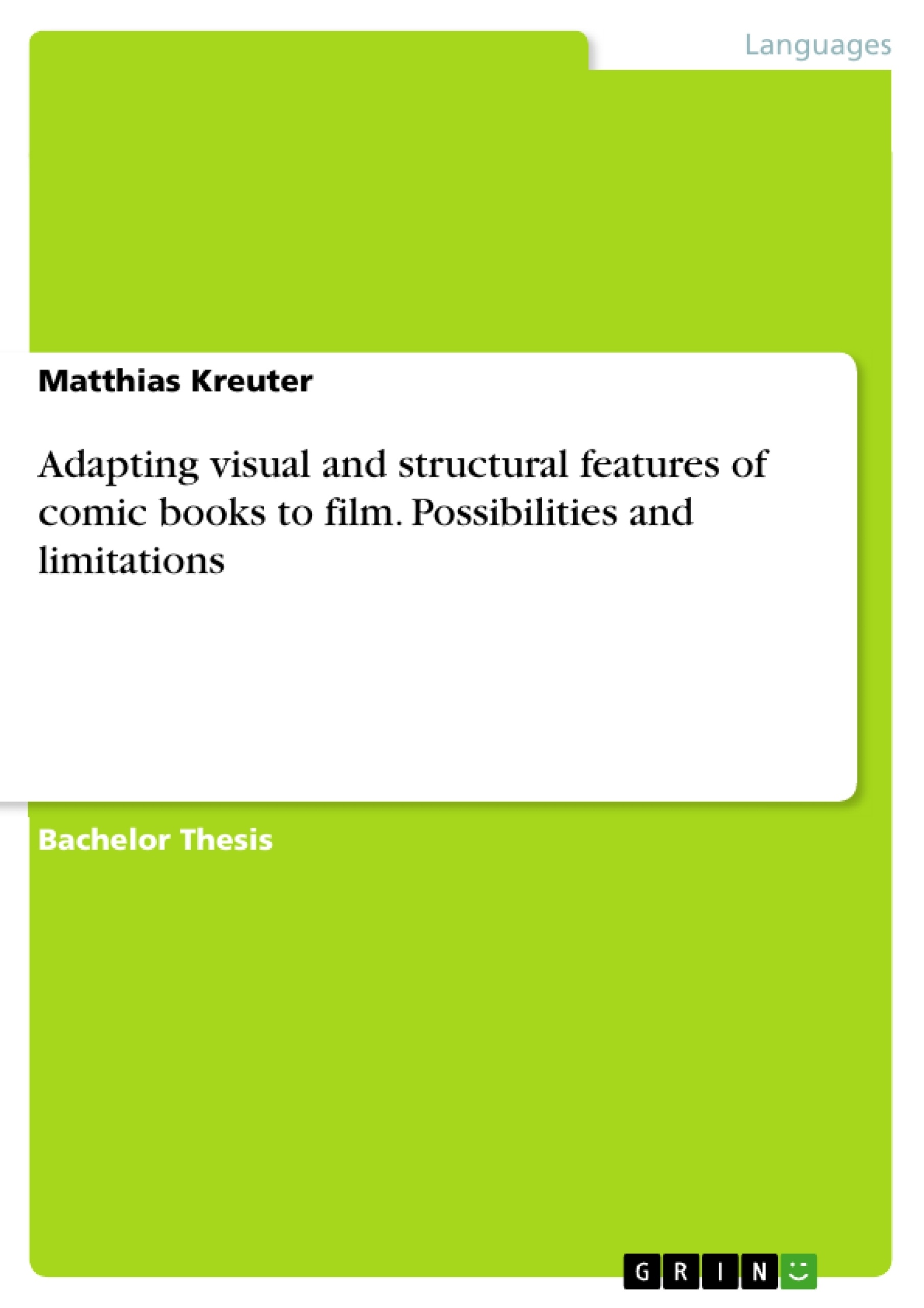
Adapting visual and structural features of comic books to film. Possibilities and limitations
Bachelorarbeit, 2015
75 Seiten, Note: 1,0
Leseprobe
Table of Contents
- 1. Introduction
- 2. Comics and Film - A Historical and Theoretical Overview
- 2.1. A History of Interaction
- 2.2. The Differences
- 2.2.1. Panels and Page Layout
- 2.2.2. Perception and Immersion
- 2.2.3. Drawing Styles
- 2.2.4. Omission of Sound and the Codependence of Image and Text
- 2.3. Adaptation Challenges and an Updated Research Premise
- 3. Adaptation
- 3.1. Imitating Panel Structure and Comic Perception
- 3.2. Transporting the Individual Drawing Style of the Illustrations
- 3.3. Turning Visual Sound into Actual Sound
- 4. Collaboration with Comic Creators and Closeness to the Original
Objectives and Key Themes
This paper examines how recent films have adapted the visual and structural features of comic books, exploring the limitations of both media. It aims to determine the extent to which film can successfully bring comics to life and the extent to which this is incompatible due to inherent differences. The analysis primarily focuses on American live-action adaptations of American comic books.
- The historical relationship between comics and film.
- Key structural and visual differences between comics and film that complicate adaptation.
- Techniques used in film adaptations to replicate comic book visual elements and storytelling.
- The impact of collaboration with comic creators on adaptation fidelity.
- The successes and failures of past and recent attempts at adaptation.
Chapter Summaries
1. Introduction: This introductory chapter establishes the context of filmic comic book adaptations, highlighting the increased number of productions in recent decades and the inherent relationship between the two media. It acknowledges the debate surrounding the successful adaptation of comics to film, citing prominent figures like Alan Moore who consider certain comics "unfilmable" due to their unique visual and narrative elements. The chapter introduces the paper's central question: to what extent can film successfully bring comics to life, and where do inherent incompatibilities exist? The scope of the analysis is defined, focusing primarily on American live-action adaptations of American comic books.
2. Comics and film a historical and theoretical overview: This chapter explores the historical and theoretical relationship between comics and film, emphasizing their shared visual characteristics and narrative structures. It highlights the early influences and mutual exchange of techniques between the two media, noting similarities even in early experimental works like Edward Muybridge's motion studies. The chapter also touches upon the debate surrounding the precise dates of the first comic strip and the first comic book film adaptation. It briefly traces the history of superhero comic adaptations, from the early comical representations to the emergence of more serious and visually ambitious adaptations.
3. Adaptation: This chapter delves into the practical challenges and strategies of adapting comics to film. It focuses on three major areas: imitating the panel structure and comic perception through techniques like stationary frames, freeze frames, slow motion, and montage; transporting the individual drawing style of the comic through graphic stylization and other techniques; and turning visual sound cues from comics into actual sound in the film, using techniques like soundtracks and the incorporation of graphic indices. The chapter provides a detailed analysis of how filmmakers attempt to overcome the inherent differences between the two media.
4. Collaboration with comic creators and closeness to the original: This chapter explores the role of collaboration between filmmakers and comic creators in achieving successful adaptations. The chapter would likely discuss how the involvement of original creators can lead to a more faithful adaptation of the visual style, narrative structure, and overall tone of the comic book. The effects of collaboration (or lack thereof) on the final product would be analyzed.
Keywords
Comic book adaptations, film adaptation, visual storytelling, panel structure, graphic novel, superhero films, intermediality, montage, graphic stylization, sound design, visual sound, adaptation techniques, Alan Moore, Sin City.
FAQ: A Comprehensive Language Preview of Comic Book Film Adaptations
What is the main topic of this document?
This document provides a comprehensive preview of a paper analyzing the adaptation of comic books into films. It includes a table of contents, objectives and key themes, chapter summaries, and keywords. The analysis focuses primarily on American live-action adaptations of American comic books.
What are the key themes explored in the paper?
The paper explores the historical relationship between comics and film, key structural and visual differences that complicate adaptation, techniques used in film adaptations to replicate comic book elements, the impact of collaboration with comic creators, and the successes and failures of past and present adaptations.
What are the main chapters and their content?
Chapter 1 (Introduction): Sets the context of comic book film adaptations, highlighting the increase in productions and the inherent relationship between the two media. It introduces the central question of the paper: to what extent can film successfully bring comics to life? Chapter 2 (Comics and Film - A Historical and Theoretical Overview): Explores the historical and theoretical relationship between comics and film, emphasizing shared characteristics and the early influences and mutual exchange of techniques. Chapter 3 (Adaptation): Delves into the practical challenges and strategies of adapting comics to film, focusing on imitating panel structure, transporting drawing styles, and turning visual sound into actual sound. Chapter 4 (Collaboration with Comic Creators and Closeness to the Original): Explores the role of collaboration between filmmakers and comic creators in achieving successful adaptations and analyzes the impact of this collaboration (or lack thereof) on the final product.
What are the key differences between comics and film highlighted in the paper?
The paper highlights differences in panel structure and page layout, perception and immersion, drawing styles, and the omission of sound in comics versus the codependence of image and text. These differences present significant challenges in adapting comics to film.
What adaptation techniques are discussed?
The paper discusses techniques like stationary frames, freeze frames, slow motion, montage, graphic stylization, soundtracks, and the incorporation of graphic indices to replicate comic book visual elements and storytelling in film.
What is the role of collaboration with comic creators emphasized in the study?
The paper emphasizes that collaboration between filmmakers and comic creators can lead to a more faithful adaptation of the visual style, narrative structure, and overall tone of the comic book. The effects of collaboration (or the lack thereof) on the final product are analyzed.
What are the keywords associated with this paper?
Comic book adaptations, film adaptation, visual storytelling, panel structure, graphic novel, superhero films, intermediality, montage, graphic stylization, sound design, visual sound, adaptation techniques, Alan Moore, Sin City.
What is the scope of the analysis in this paper?
The analysis primarily focuses on American live-action adaptations of American comic books.
Details
- Titel
- Adapting visual and structural features of comic books to film. Possibilities and limitations
- Hochschule
- Universität zu Köln (Englisches Seminar)
- Note
- 1,0
- Autor
- Matthias Kreuter (Autor:in)
- Erscheinungsjahr
- 2015
- Seiten
- 75
- Katalognummer
- V424267
- ISBN (eBook)
- 9783668704046
- ISBN (Buch)
- 9783668704053
- Dateigröße
- 8292 KB
- Sprache
- Englisch
- Schlagworte
- Comics Film Superhelden Verfilmungen Pop-Kultur
- Produktsicherheit
- GRIN Publishing GmbH
- Preis (Ebook)
- US$ 32,99
- Preis (Book)
- US$ 46,99
- Arbeit zitieren
- Matthias Kreuter (Autor:in), 2015, Adapting visual and structural features of comic books to film. Possibilities and limitations, München, Page::Imprint:: GRINVerlagOHG, https://www.diplomarbeiten24.de/document/424267
- Autor werden
- Ihre Optionen
- Vertriebskanäle
- Premium Services
- Autorenprofil
- Textarten und Formate
- Services für Verlage, Hochschulen, Unternehmen

- © GRIN Publishing GmbH.
- Alle Inhalte urheberrechtlich geschützt. Kopieren und verbreiten untersagt.
- info@grin.com
- AGB
- Open Publishing
Der GRIN Verlag hat sich seit 1998 auf die Veröffentlichung akademischer eBooks und Bücher spezialisiert. Der GRIN Verlag steht damit als erstes Unternehmen für User Generated Quality Content. Die Verlagsseiten GRIN.com, Hausarbeiten.de und Diplomarbeiten24 bieten für Hochschullehrer, Absolventen und Studenten die ideale Plattform, wissenschaftliche Texte wie Hausarbeiten, Referate, Bachelorarbeiten, Masterarbeiten, Diplomarbeiten, Dissertationen und wissenschaftliche Aufsätze einem breiten Publikum zu präsentieren.
Kostenfreie Veröffentlichung: Hausarbeit, Bachelorarbeit, Diplomarbeit, Dissertation, Masterarbeit, Interpretation oder Referat jetzt veröffentlichen!
- GRIN Verlag GmbH
-
- Nymphenburger Str. 86
- 80636
- Munich, Deutschland
- +49 89-550559-0
- +49 89-550559-10
- info@grin.com
-









